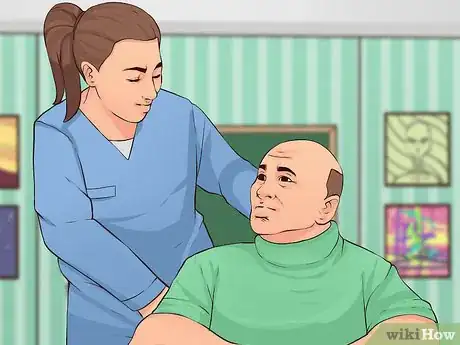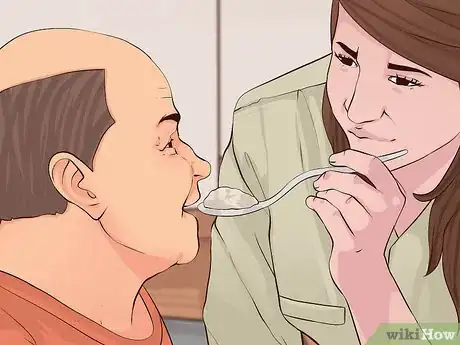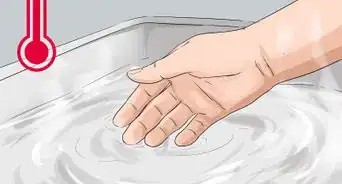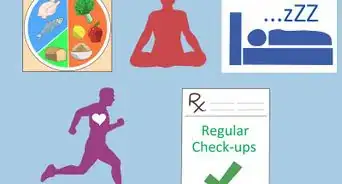This article was medically reviewed by Sarah Gehrke, RN, MS. Sarah Gehrke is a Registered Nurse and Licensed Massage Therapist in Texas. Sarah has over 10 years of experience teaching and practicing phlebotomy and intravenous (IV) therapy using physical, psychological, and emotional support. She received her Massage Therapist License from the Amarillo Massage Therapy Institute in 2008 and a M.S. in Nursing from the University of Phoenix in 2013.
There are 12 references cited in this article, which can be found at the bottom of the page.
This article has been viewed 23,551 times.
Providing care to someone who has suffered from a stroke is a challenging job. Whether the person is your spouse, parent, sibling, or friend, taking on the role of a caregiver can be stressful. To keep yourself physically and emotionally healthy, it is important to find effective ways to manage your stress, cope with changes in the relationship, and provide good care for your patient within your abilities. If you are in a situation where your patient is being abusive to you, then there are also some things you can do to protect yourself and stop the abuse.
Steps
Managing Stress
-
1Watch for signs of stress from caregiving. Being a caregiver is stressful, so it is important to keep your stress levels under control. Some signs that you may be overly stressed from your caregiving responsibilities include:[1]
- Often feeling tired, fatigued, overwhelmed, worried, irritable, angry, or sad.
- Not getting enough sleep.
- Losing or gaining weight without trying.
- Not feeling interested in doing things you used to enjoy.
- Feeling achy or in pain much of the time.
- Taking drugs (illegal or prescription) or drinking to feel better.
-
2Ask for help when you feel overwhelmed. Reaching out for help when you have too much on your plate is an essential coping strategy for caregivers. If you feel overwhelmed, be sure to tell a friend or family member and ask for help. Try saying something like, “I am having a hard time getting everything done today. Can you please some and help me for an hour or two?”[2]
- You might consider making a list of your daily tasks, too. This by itself can be a good way to cope. You can also use it to delegate things to people who offer to help you.[3]
- For example, you might include items on the list such as “make dinner,” “take out the trash,” “do the dishes,” “give Sue a bath,” and “tidy up the bathroom.” List as many of your daily or weekly to-do items as you can think of on the list so that people who want to help you can easily pick something to do to help you out.
- Try finding help online, as well. Online organizing tools allow caregivers to post requests for help with things like meds, meals, and doctor’s appointments. You can also search the national respite locator to find a respite service near you.[4] [5]
Advertisement -
3Find a support group. Talking to other people who understand what you are experiencing can help you to cope with your situation. Look for a stroke survivor caregiver group or a general caregiver group in your area. Connecting with other caregivers will give you a chance to share your experiences and hear about the experiences of other people.[6]
- You may also learn about different coping techniques people have tried and gain insight for your own situation based on what has worked for other people.
- Ask your doctor for information on caregiver support groups in your area.
-
4Consider seeing a therapist. The emotional weight of caring for someone who has survived a stroke can be hard to handle on your own. If you are having trouble managing your emotions, then you may want to talk with someone who can help you, such as a therapist.[7]
- Ask your doctor for information on therapists in your area.
-
5Take good care of yourself. Your physical health can affect your emotional well-being. To ensure that you are as emotionally healthy as possible, make sure that you are doing things to ensure good physical health, such as:[8]
- Eating healthy foods.
- Exercising regularly.
- Drinking plenty of water.
- Getting adequate rest.
- Making time for relaxation or meditation every day.
Coping with Changes in the Relationship
-
1Remind yourself that behavioral changes are due to the stroke. People who have strokes often undergo significant personality changes as a result. Witnessing this behavior can be distressing, but it is important to keep in mind that this behavior is due to the stroke. It is not within the person’s control or within your control.[9]
- For example, if your patient says or does something out of character for him or herself, then try telling yourself something like, “That is the stroke talking.”
-
2Grieve the loss of the previous relationship you had with the patient. Part of the emotional weight that you bear as a caregiver is a longing for the relationship you once had with the person. Whether the person is your spouse, parent, sibling, or friend, it is important to grieve the loss of the relationship that you once had so that you can move forward with your life.[10]
- Try writing a goodbye letter to the person to help you express your feelings about the loss. In the letter, you can talk about what you loved about the relationship and acknowledge that the relationship has changed as a result of the stroke.
- Allow yourself to cry, get angry, and feel the pain of your loss as well. Fighting against your feelings will not make them go away. Write about your feelings or talk to someone about them.
-
3Communicate in an explicit way. Communicating with your patient can sometimes be a challenge, especially if he or she has trouble remembering things or understanding concepts that were once familiar to him or her. To help reduce confusion for your patient and make communicating less frustrating for you, try to be as explicit as possible. This may take some practice, but you can do little things like:[11]
- Using proper names for people, places, and things to prevent confusion. For example, instead of saying, “We’re going to see the doctor,” say, “We are going to see your neurologist, Dr. Jones, at 1 pm today.”
- Providing frequent reminders. For example, you can provide reminders every hour leading up to something and then provide reminders closer to the event as well. Try saying things like, “We will be leaving in one hour,” “Your sister Margaret is coming over in 30 minutes,” and “Tomorrow is your granddaughter Ashley’s birthday.”
- Answering questions. Your patient may ask lots of questions out of confusion or frustration, so try to be patient and answer them as best you can to help your patient feel more at ease.
-
4Savor the positive moments. When someone is suffering from the effects of a stroke, his or her health may deteriorate and this can cut down on the positive interactions that you have together. Therefore, make sure that you savor the moments when your patient is in good spirits or when he or she is having a good day.[12]
- Use your patient’s good days as opportunities to talk with him or her, reflect on happy memories, and build your bond. For example, you might ask questions about your patient’s childhood, remind him or her of a happy day in your relationship, or even just let the patient guide the conversation and be willing to listen to him or her talk for a while.
Providing Good Care for Your Patient
-
1Focus on providing basic care. It is common for caregivers to want to set goals for their patients, but setting unrealistic goals for your patient may lead to disappointment. Instead, try to set goals to meet your patient’s basic care needs, such as keeping your patient clean, comfortable, and well-fed.[13]
- Avoid setting unrealistic goals for your patient. For example, you might want to work on language skills for two hours every day with your patient, but with all of your other responsibilities, this might not be realistic.
-
2Encourage healthy habits. Your patient may feel better and be in better spirits if you encourage him or her to practice more healthy habits. This can also reduce the chances of your patient having another stroke. Try to encourage healthy habits, such as:[14]
- Eating healthy foods.
- Not smoking.
- Getting regular exercise.
- Getting adequate rest.
-
3Modify your patient’s environment for safety and convenience. Making some modifications to the environment can also help to ease your workload. Any modifications that you can make to provide a safer environment for your patient can make your life easier.[15]
- Look into things like putting a hand rail in next to the toilet, getting child locks for cupboards with dangerous chemicals inside of them, or getting a hospital bed with electronic controls for your patient to sleep in.
-
4Look into other resources that might make life easier. Your patient may qualify for certain services or resources that can improve his or her life. Requesting these services can also ease your burden as well and make caring for the person a little easier. These may include:[16]
- Visits from a home health aide or nurse to provide baths and other personal care.
- Meal delivery services, such as Meals on Wheels.
- Rides from a local transportation service to make getting to doctor’s appointments easier.
Protecting Yourself from Abusive Behavior
-
1Anticipate abuse from your patient. You may experience physical or emotional abuse in your time as a caregiver. This is because many people who experience a stroke have personality changes that can cause them to become abusive to those closest to them.
- Abuse may include physical actions such as hitting, biting, or scratching. It may also include emotional abuse, such as calling you names, yelling at you, or making unreasonable demands of you.
- Remember that this behavior has nothing to do with you or anything you are doing. You cannot change it by changing your behavior. However, you can use some strategies to stop the abuse, get support, and get help for the patient.
-
2Warn the patient that you will not put up with abuse. If you experience abuse from your patient warn him or her that you will not put up with it. For example, if your patient begins to yell at you for something trivial, then let him or her know that if the yelling does not stop that you will walk away.
- Try saying something like, “I don’t deserve to treated like this and if you do not stop then I will leave the room.” If the patient does not stop, then walk away. Go to another room or go outside for five minutes or more if necessary. Do not return until the patient has calmed down.
- If the patient starts yelling again or abusing you in another way, walk away again. Keep doing this to show the patient that you are serious and that you refuse to put up with his or her abuse.
-
3Talk to other family members. If the abuse continues despite walking away when the patient is yelling at you, then talk to the patient’s other family members about it. Let them know what has been happening and what you have done to try to stop it. Request their help with the situation.[17]
- Bringing in other family members may help because some stroke survivors will target their caregiver and be more reasonable around other people. Therefore, you might request that another family member helps you when you are providing care to the patient to serve as a buffer from the abuse.
- Another family member might also be willing to provide care for the patient part of the time to take some of the pressure off of you and give you some relief from the abuse.
-
4Discuss the patient’s behavior with his or her physician. If the abuse continues despite bringing in other family members, then enlist the help of your family physician. Tell him or her what has been happening and what you have done to try to stop the abuse. Your patient’s physician may recommend a psychiatric consultation for the patient to determine if he or she is suffering from a mental health condition as a result of the stroke.[18]
- Your patient may need to undergo therapy sessions and/or take medication to help control a mental health condition, such as depression or bipolar disorder.
References
- ↑ https://www.womenshealth.gov/a-z-topics/caregiver-stress
- ↑ https://www.helpguide.org/articles/stress/caregiver-stress-and-burnout.htm
- ↑ https://www.helpguide.org/articles/stress/caregiver-stress-and-burnout.htm
- ↑ http://lotsahelpinghands.com/
- ↑ https://archrespite.org/respitelocator
- ↑ https://www.caregiver.org/connecting-caregivers/support-groups/
- ↑ https://my.clevelandclinic.org/health/diseases/9225-caregiver-burnout
- ↑ https://www.ucsfhealth.org/education/self-care-for-caregivers
- ↑ https://www.stroke.org/en/about-stroke/effects-of-stroke/emotional-effects-of-stroke
- ↑ https://www.apa.org/topics/families/grief
- ↑ https://www.ucsfhealth.org/education/coping_strategies_for_vascular_dementia_caregivers/
- ↑ https://www.ucsfhealth.org/education/coping_strategies_for_vascular_dementia_caregivers/
- ↑ https://www.ucsfhealth.org/education/coping_strategies_for_vascular_dementia_caregivers/
- ↑ https://www.ucsfhealth.org/education/coping_strategies_for_vascular_dementia_caregivers/
- ↑ https://www.ucsfhealth.org/education/coping_strategies_for_vascular_dementia_caregivers/
- ↑ https://www.stroke.org/-/media/stroke-files/caregiver-support/caregivers-guide-to-stroke/caregiverguidetostroke_2020.pdf?la=en
- ↑ https://www.stroke.org/-/media/stroke-files/caregiver-support/caregivers-guide-to-stroke/caregiverguidetostroke_2020.pdf?la=en
- ↑ https://www.stroke.org/en/help-and-support/for-family-caregivers/15-things-caregivers-should-know-after-a-loved-one-has-had-a-stroke













































































Medical Disclaimer
The content of this article is not intended to be a substitute for professional medical advice, examination, diagnosis, or treatment. You should always contact your doctor or other qualified healthcare professional before starting, changing, or stopping any kind of health treatment.
Read More...